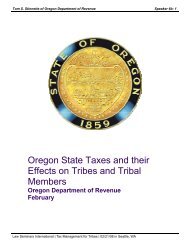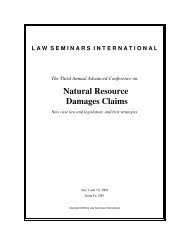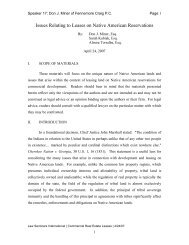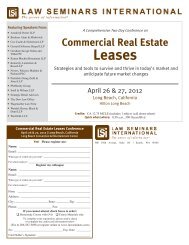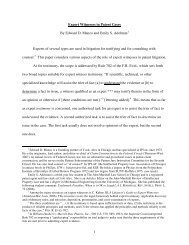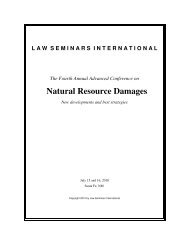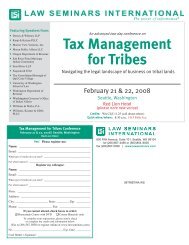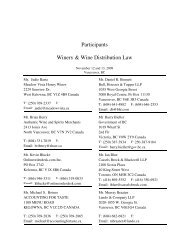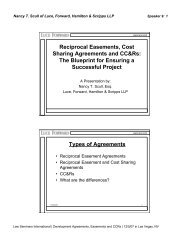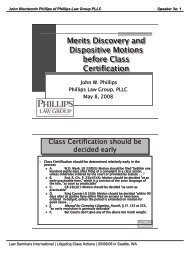LSI 2010 Real Estate Joint Ventures conference materials.pdf
LSI 2010 Real Estate Joint Ventures conference materials.pdf
LSI 2010 Real Estate Joint Ventures conference materials.pdf
You also want an ePaper? Increase the reach of your titles
YUMPU automatically turns print PDFs into web optimized ePapers that Google loves.
Brian Todd of Davis Wright Tremaine LLP<br />
Andrew H. Zuccotti of K&L Gates LLP<br />
2. Alternate Economic Effect Test. To permit the members of an<br />
LLC (or the limited partners of a limited partnership or the partners of an LLP) to<br />
preserve their limited liability while at the same time matching tax and economic<br />
consequences of profit and loss allocations, the regulations provide an alternative test for<br />
economic effect. This test requires that the first two prongs of the regular economic<br />
effect test (maintenance of capital accounts and liquidating distributions in accordance<br />
with capital account balances) be satisfied. Additionally, instead of requiring members to<br />
have a deficit make up obligation, if the partnership or limited liability company<br />
agreement contains a “qualified income offset provision,” the regulations will deem an<br />
allocation to have economic effect to the extent it does not cause, or increase, a deficit<br />
balance in a partner’s or member’s capital account as of the end of the year in which the<br />
allocation occurs in excess of any limited amount that the partner or member is by<br />
contract obligated to restore.<br />
3. Adjustments for Reasonably Expected Events. In making the<br />
determination whether an allocation will create (or increase) a deficit in a member’s<br />
capital account in excess of any amount the member is obligated to restore, the<br />
regulations require not only that all allocations for the year be taken into account, but, in<br />
addition, that certain allocations or events reasonably anticipated to occur in future years<br />
be taken into account. The most relevant of these events typically relates to future<br />
distributions. This rule requires that the partner’s or member’s capital account be<br />
reduced by any distributions expected to be made in future years, to the extent such<br />
distributions exceed offsetting increases to the member’s capital account that reasonably<br />
are expected to occur during (or prior to) the years in which the distributions are expected<br />
to be made. The purpose of this rule is to prevent a loss allocation from being made to a<br />
partner or member in one year, which drops his capital account balance to (or close to)<br />
zero when it is expected that a distribution will be made in a subsequent year without any<br />
offsetting profit allocation, which distribution would create a deficit in the member’s<br />
capital account. Absent this requirement, since the member has no obligation to make a<br />
contribution to the LLC to restore his capital account deficit, and consequently would not<br />
bear the economic burden associated with the loss earlier allocated to him, the goal of<br />
matching economic and tax consequences would fail.<br />
4. Qualified Income Offset. Notwithstanding that an allocation will<br />
have economic effect under the alternate test only to the extent it does not create (or<br />
increase) a deficit in a partner’s or member’s capital account, after taking into account<br />
reasonably expected distributions to the partner or member, a partner’s or member’s<br />
capital account nonetheless may become negative as a result of unexpected events or<br />
distributions. Since the partner or member has no obligation to restore the deficit, and<br />
cannot in that way bear the economic burden associated with the loss contributing to the<br />
deficit, the regulations employ a gross income allocation mechanism as a substitute for<br />
the deficit restoration obligation. In other words, a partner or member whose capital<br />
account unexpectedly drops below zero is required to bear the economic burden of the<br />
loss creating the deficit by receiving a subsequent allocation of gross income to restore<br />
his or her capital account to zero as quickly as possible. The regulations denominate this<br />
gross income allocation a “qualified income offset,” and require that a partnership or<br />
LLC agreement contain a qualified income offset provision in order to satisfy the<br />
Speaker 11: 4<br />
Speaker 12: 4<br />
DWT 12372832v1 0053770-000001<br />
Law Seminars International | <strong>Real</strong> <strong>Estate</strong> <strong>Joint</strong> <strong>Ventures</strong> and Funds | 02/08/10 in Seattle, WA




